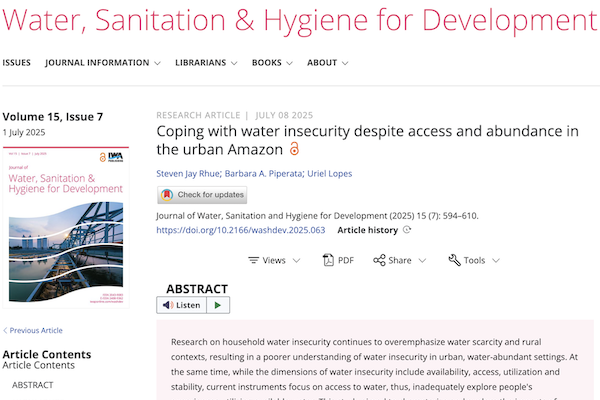New Article in the Journal of Water Sanitation and Hygiene for Development!

In their new article Rhue et al. characterize household water insecurity in the city of Belém, Pará, Brazil; an urban metropolitan located at the mouth of the Amazon River where water is abundant, but issues related to water service and quality are persistent. Using the Household Water Insecurity Experiences (HWISE) Scale, administered across 188 households, (110 Low Socio-Economic Status – LSES and 78 High Socio-Economic Status – HSES), Rhue et al. found that 28% of households were water insecure and that LSES households were disproportionately affected. However, further investigation of experiences with household water in a subsample of 47 LSES households, using a novel tool, the Household Water Infrastructure and Utilization (HWIU) instrument, revealed that HWISE likely underestimated the full extent of water insecurity in Belém.
The HWIU is an ethnographically grounded instrument designed to assess all points of water within, and in immediate proximity, of the home (e.g. sinks, spigots, showers, containers, etc.). Using a standard set of questions, it examines how water is used, where it comes from (i.e. the ultimate source), and any problems with said water. According to the HWIU, 87% of subsample households reported problems with household water utilization regardless of household water insecurity status. Conversations with female heads of household revealed that common coping strategies included storing water in containers and large rooftop tanks, using storebought and/or homemade filters, and purchasing bottled water among others. While somewhat effective, these did not guarantee safe or sufficient water and often imposed financial and logistical burdens.
Additionally, the study highlights that income alone does not shield households from water insecurity (as both HSES and LSES households were found to be water insecure); and that standardized measures such as the HWISE, may fail to adequately capture the complexity of household water experiences in an urban and water abundant environment. Rhue et al. advocate for locally grounded, ethnographic instruments like the HWIU to better assess household water insecurity. Finally, the authors further emphasize the need to consider the costs and consequences of coping strategies in future research and policy.
Read the full article on the Journal for Water, Sanitation, and Hygiene for Development's Website
Image: Screen capture from the Journal for Water Sanitation and Hygiene for Development Website
